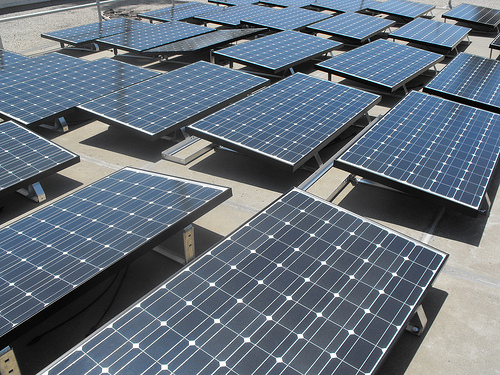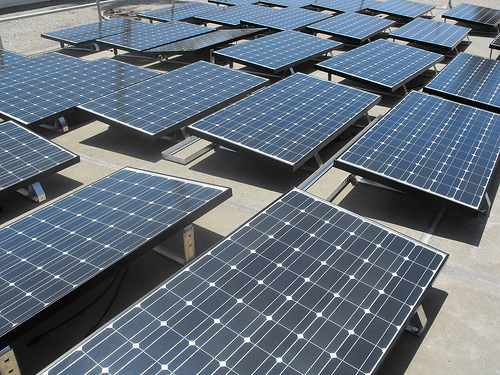 Do panels trump plastic?Photo courtesy Port of San Diego via FlickrThe California Legislature started out the week in the green by passing the nation’s first energy storage bill. But legislators quickly ran into the red Wednesday when they failed to approve legislation to impose a statewide ban on plastic bags, or to codify Gov. Arnold Schwarzenegger’s (R) executive order that utilities obtain a third of their electricity from renewable sources by 2020.
Do panels trump plastic?Photo courtesy Port of San Diego via FlickrThe California Legislature started out the week in the green by passing the nation’s first energy storage bill. But legislators quickly ran into the red Wednesday when they failed to approve legislation to impose a statewide ban on plastic bags, or to codify Gov. Arnold Schwarzenegger’s (R) executive order that utilities obtain a third of their electricity from renewable sources by 2020.
But don’t go crying in your organic beer yet. On Thursday, the California Public Utilities Commission signed off on 650 megawatts of new solar energy contracts and programs.
Which all goes to show that in the Golden State, environmental politics are not green and brown. And despite the unknown fate of Proposition 23, the oil company-bankrolled ballot initiative to suspend California’s global warming law, the state’s panoply of green laws allows progress to be made on various fronts.
The utilities commission, for instance, approved contracts for two giant photovoltaic solar farms to be built in the Mojave Desert by First Solar. Together they will supply 550 megawatts of electricity to the utility Southern California Edison.
Commissioner Timothy Simon noted at Thursday’s energy commission meeting in San Francisco that the price for that electricity is lower than previous solar contracts, another sign that photovoltaic power is edging ever closer to edging out fossil fuels. The price also speaks to the ability of First Solar, an Arizona-based thin-film solar company, to win and begin to execute big projects.
The commission also greenlighted San Diego Gas & Electric’s proposal for 100-megawatt’s worth of small-scale photovoltaic projects.
Most installations will be 1 or 2 megawatts and built in parking lots or other open spaces where they can be plugged into the grid without expensive transmission upgrades. The move comes on top of 1,000 megawatts of distributed solar generation that the utilities commission previously approved for California’s two other big utilities.
Michael R. Peevey, the president of the utilities commission, said despite the failure of the state legislature to institutionalize the 33 percent renewable portfolio standard — currently subject to reversal by the next governor — California was on a solar streak.
“With approval of this project we’ll have added 1,100 megawatts of photovoltaic electricity by the three utilities,” said Peevey, noting separately that the California Solar Initiative will add another 3,000 megawatts and that by year’s end, regulators are poised to approve big solar farms that will generate 4,700 megawatts of electricity.
“These are big, big numbers,” Peevey added. “Independent of the legislature, we’re moving to a RPS (Renewable Portfolio Standard) economy.”



